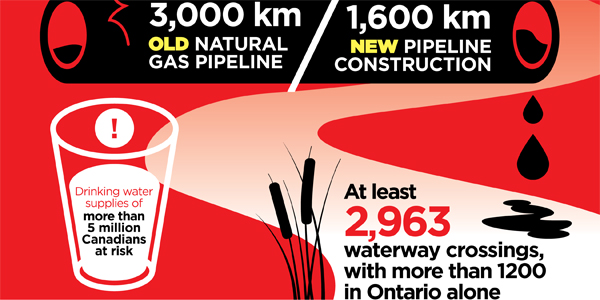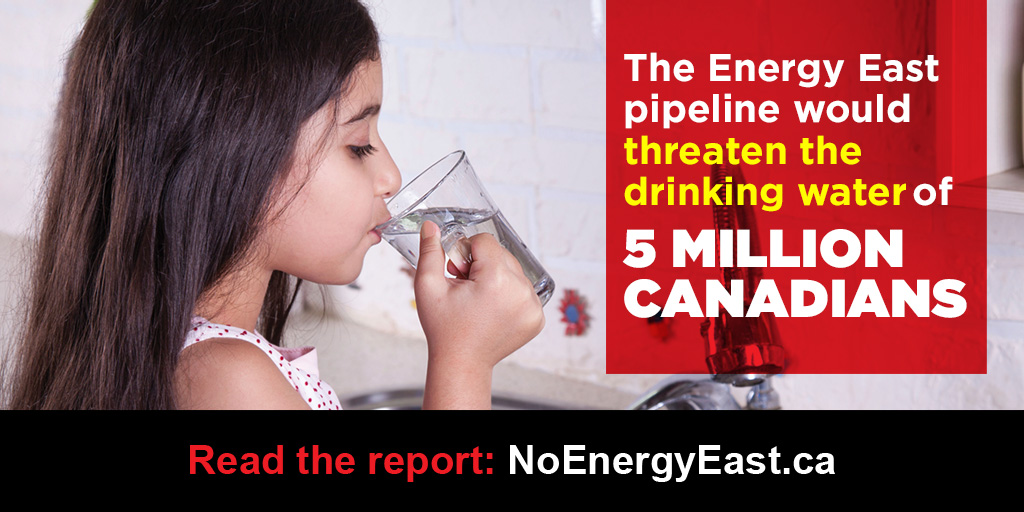Like this article? rabble is reader-supported journalism. Chip in to keep stories like these coming.
The Council of Canadians joined with Environmental Defence, Transition Initiative Kenora and regional partners in the release of a new report on the serious risks TransCanada’s proposed Energy East pipeline presents to drinking water sources from along its 4,400-kilometre path from Alberta to New Brunswick.
Over 5 million people rely on drinking water sources within spill reach of the Energy East pipeline.
By province, the 1.1 million barrel per day pipeline risks the drinking water of:
- 676,613 residents in Manitoba
- 1,040,788 residents in Ontario
- 3,213,353 residents in Quebec
- 130,679 residents in New Brunswick
The report looks at a number of key case studies including:
Winnipeg: The pipeline runs alongside, and even crosses below the 100-year-old concrete aqueduct that supplies of Winnipeg’s drinking water.
North Bay: The pipeline crosses a number of tributaries close to Trout Lake, the sole drinking water source for North Bay.
Oxford Aquifer: Classified as a highly vulnerable aquifer by the Ontario government because it is so porous, the pipeline runs overtop the aquifer which North Grenville residents rely on for drinking water.
Montreal area: The pipeline crosses Rivière des Mille-Îles and Rivière des Prairies which serve Laval and other North Shore communities in the Montreal CMA. Energy East would also cross Rivière L’Assomption upstream of the water intake for Repentigny and L’Assomption.
Saint John: The pipeline would cross the Mispec River about 3 kilometres from Latimore Lake, a drinking water source for Saint John. In another location, the pipeline is on a hill just 3 kilometres outside the outer edge of the protected Loch Lomond watershed. A spill here could flow downhill towards the protected area, home to three Saint John drinking water lakes.
What are the chances of a major pipeline spill?
The risk is considerable. We estimate, based on TransCanada’s Canadian pipeline safety track record, Energy East has a 15 per cent likelihood of a full-bore rupture somewhere along the pipeline path.
In investigating TransCanada’s track record, we’ve also concluded there is a significant gap between what the company promises on pipeline safety, and their actual practices. For example, at open houses for Energy East hosted by TransCanada, their electronic spill detection system is typically promoting as a key first line of defence (the quicker a spill is found, the better). Looking at the leaks they’ve had on the mainline system of pipelines (one of which is slated for conversion from natural gas to oil for Energy East) only one, arguably two of the nine ruptures since 1992 was discovered by their leak detection system. The others were found by TransCanada staff, passersby and even an OPP officer driving by witnessing a fireball in the sky.
TransCanada’s most recent leak on the Keystone pipeline in South Dakota reported this week was again, discovered by a landowner.
While TransCanada has suggested they could respond to a leak within 22 minutes, their response times for the mainline pipeline leaks vary greatly, some in minutes (typically near pump stations), one was around three hours, another took seven hours before the natural gas was isolated to the damaged section of pipe. A seven-hour spill of the Energy East pipeline would be devastating.
Even if Energy East’s leak detection system works reliably, there is still a massive problem. A large-scale spill would still be possible as the proposed leak detection system can only detect leaks greater than 1.5 per cent of the pipeline’s capacity.101 Based on a total capacity of 1.1 million barrels per day, an undetected leak of 1.5 per cent could release up to 16,500 barrels or 2.6 million litres of oil in a single day
In other words, Energy East is a recipe for disaster. The question is not when it would leak, but where and for how long.
Not my drinking water — not anyone’s drinking water
We don’t think this is an acceptable risk for anyone’s drinking water source. Particularly because this pipeline will ship large quantities of diluted bitumen which presents heightened risks when spilled.
As outlined in the report, a recent report by the U.S. National Academy of Sciences found diluted bitumen can create even greater environmental risks when spilled. In 2010, an Enbridge pipeline spilled 3.8 million litres of diluted bitumen in the Kalamazoo River, which spread nearly 60 kilometres downstream. Cleanup efforts were complicated by submerged bitumen, requiring extensive dredging — a process that took years and cost more than $1 billion. Six years later, the river is still degraded as some submerged oil contamination remains.
This new report compliments our earlier report mapping out key waterways crossed by Energy East.

Read and share the full report here.
Like this article? rabble is reader-supported journalism. Chip in to keep stories like these coming.



